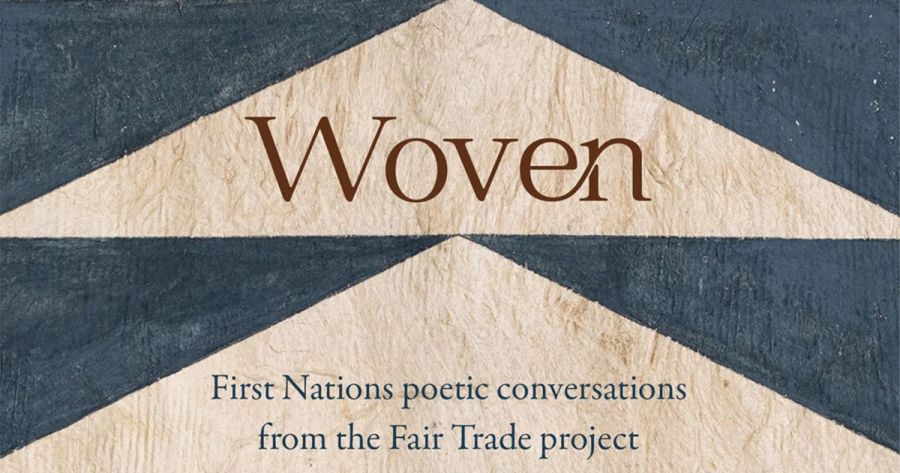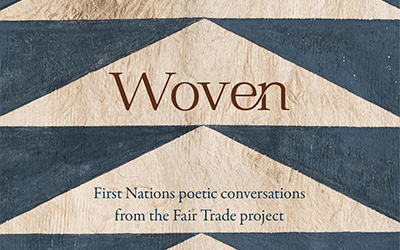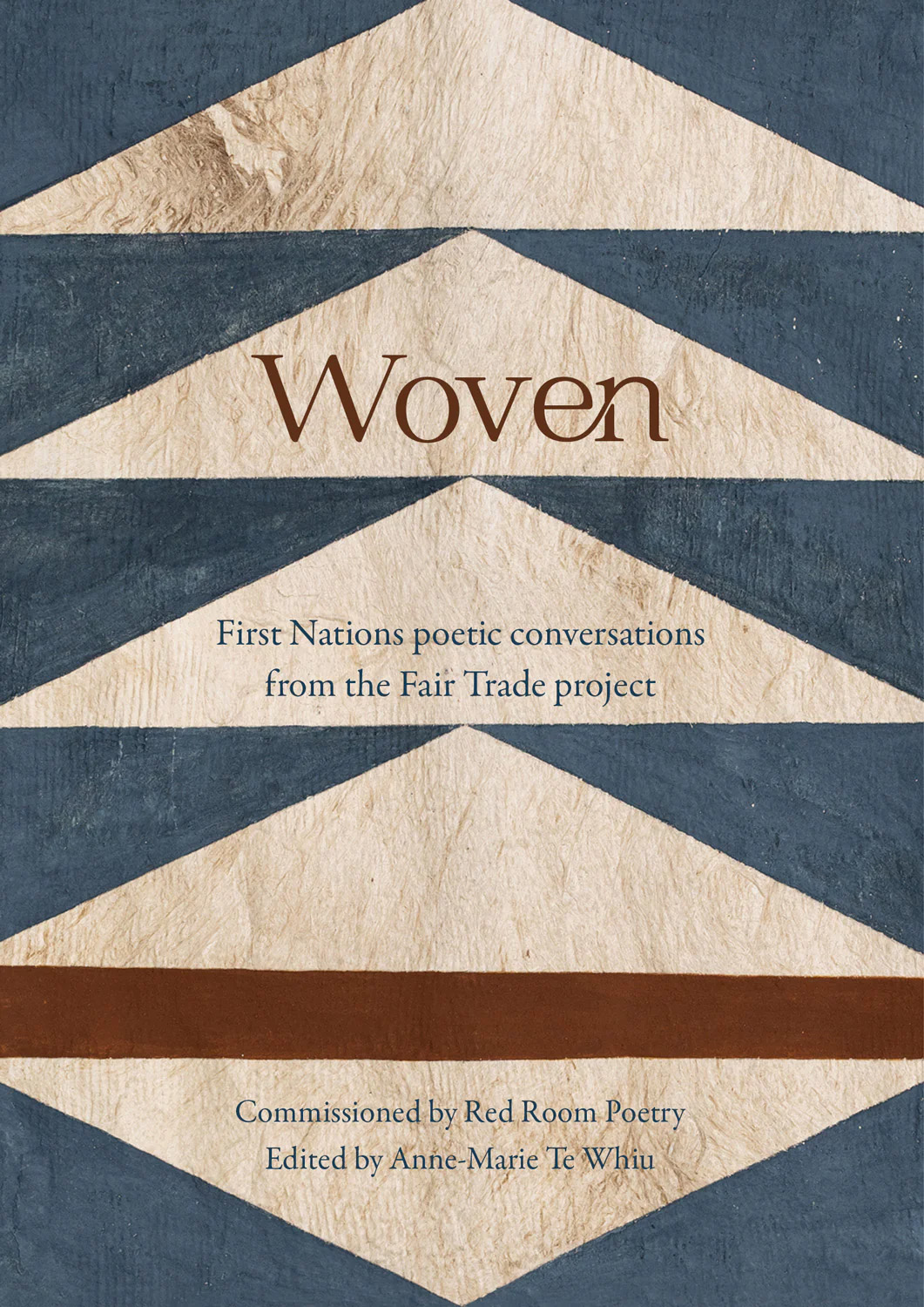
- Free Article: No
- Contents Category: Poetry
- Review Article: Yes
- Article Title: Poetic tapestries
- Article Subtitle: An ambitious multi-vocal project
- Online Only: No
- Custom Highlight Text:
The concept of Woven, a Fair Trade project from Red Room Poetry, seems simple but the reality is complex: one local First Nations poet is paired with another First Nations poet from another continent, and together they create a poem. This is an ambitious undertaking for the poets themselves and especially for the editor, Māori poet Anne-Marie Te Whiu, who should be commended for stewarding this project through the last few tumultuous years. The resulting book is a gorgeous tapestry of weavings from some fine poets.
- Featured Image (400px * 250px):

- Alt Tag (Featured Image): Mykaela Saunders reviews ‘Woven: First Nations poetic conversations from the Fair Trade project’ edited by Anne-Marie Te Whiu
- Book 1 Title: Woven
- Book 1 Subtitle: First Nations poetic conversations from the Fair Trade project
- Book 1 Biblio: Magabala Books, $27.99 pb, 160 pp
- Book 1 Cover Small (400 x 600):

- Book 1 Cover (800 x 1200):

There are two styles of poems in Woven: those whose authors speak in conversation with each other; and those who speak in concert together, where the voices of the poets merge as one ‘we’. In Woven, there are stronger and less successful poems in both styles. Regardless of style, the most interesting poems in this anthology are those where the poem is greater than the sum of its parts (or the sum of its poets): for example, where the poets have created something novel and exciting, through a new form or as a conversation, rather than just being two separate poems placed together as one. These intentional poems are their own entities; two distinctly different materials are woven into a brand new piece. It is clear that a lot of thought went into their structuring.
This is a hard thing to get right – there is no tried and true formula. Some pairings appear to be at a natural advantage, where both poets are highly decorated, though this doesn’t guarantee success. Sometimes, pairings from the same generation or poetic style make it work, but sometimes it doesn’t; sometimes those with big differences in age or gender or style create the most interesting work. Paradoxically, some of the strongest individual poems were the least successful couplings; sometimes the most skilled poets were the least relational. In this review I want to think about what works and what doesn’t, and why this is the case.
The conversational poems are explicit about which poet is speaking and their positionality. As with healthy relationships, the poets are not only speaking to each other but listening, too. ‘Story Tree’, by Ali Cobby Eckermann and Joy Harjo, is a powerful exchange, the sharing of sad and deep experience. Harjo first writes to Eckermann, who responds, and the product is a short poem written together. This other-worldly and epic working is a meeting of minds across cultures, yet the inner worlds are part of the same story. ‘Forgotten is Just a Word Nonetheless’, by Tony Birch and Simon Ortiz, consists of four poems, two written by each poet in conversation. It is a moving meditation on brothers, death, words for grief and other feelings, and the examination of mature masculinity. ‘Tadra / Buar (To Dream)’, by Bebe Backhouse-Oliver and Peter Sipeli, is another beautiful conversation between the two, short and sweet, first led by Sipeli, with Backhouse-Oliver responding and closing.
‘The Colour of Connection’, by Charmaine Papertalk Green and Anna Naupa, is a wonderfully generous conversation, an exchange of culture with a meeting place created between the two. Each speaker is acknowledged by the next speaker – an explicit reciprocity not always evident in other poems – and in this way the poets talk to each other rather than over or across each other. Woven closes with the ambitious ‘a poem in which two indigiqueer hotties definitely do not overshare about anything featuring big-fish, big-birds and revolutionary violence’, by Raelee Lancaster and essa may ranapiri. It is deeply funny, thrilling, sexy, grim, and disturbing. It was clear who the speakers were from the formatting, and again, the poets spoke to each other. Even when they segued ‘off topic’, the yarn was always brought back. This was a marvellously expansive yet cohesive poem.
Some conversational poems didn’t seem as cohesive or intentionally produced as the others, making the book an uneven reading experience. Despite being accomplished as individual poems, these works read as though the poets were talking across and at each other without the reciprocal deep listening and responsiveness that is foundational for healthy relations. In this respect, conversational poems can be likened to duets. Some duets were more like two separate songs, written separately and put together after the fact. Other duets were unbalanced, akin to a lead solo with back-up vocals, where one poet dominates, overpowering the poem, and the other poet responds or echoes but isn’t engaged with in turn. There might be some common ground in these couplings, but it didn’t seem as if the poets worked together closely enough for them to become as cohesive as the aforementioned poems. Perhaps these poems needed a little more thinking and working to bring those connections closer together on the page.
The we poems are the riskiest, and two stand out. ‘Circuit Breaker’, by Ellen van Neerven and Layli Long Soldier, is a formally inventive set of poems made using phrases from the email correspondence between the two (the accompanying note says that ‘authorship of each section is shared’). The effect is strange and uncanny; familiar to me from my correspondence with other blackfellas in the arts, and our negotiations of private selves in public spaces, balancing the cultural and the commercial. The subject matter is a novel mix of mundane and heavy, and reads as though artificial intelligence software wrote a surrealist simulacra of email poetry. ‘The Poem’, by Alison Whittaker and Nadine Anna Hura, is a funny, clever, and heavy ‘we’ poem. It could be read as a poem that is written together, though I began to get a sense for distinct lines and threads of story by the different speakers. There is camaraderie here, a sense of shared anxieties and abasements and living through global history in different colonies, and talking through it with a similar sense of humour and understanding. Other ‘we’ poems missed the mark, flattening the unique voices into one mash-up and losing the vocal specificity and cultural markers of other poems. I found it difficult to suspend disbelief reading these and just enjoy them as though one person wrote them when I knew there were two responsible.
Poetry critics like to bang on about who the speaker of the poem is, but in explicitly cultural (and cross-cultural) projects like Woven the author is very much alive, and it is especially important to know who is speaking for or from which culture. Sometimes the context clues aren’t there, and I spent too much time figuring out which poet wrote which part of the poem. Sometimes this was intentional, as with the ‘we’ poems, hybridising voice and subject into a pan-Indigeneity. In a few of the unmarked poems, I was able to pick out who was speaking straight away and I owe this to a familiarity with the poets and their styles, but I imagine markers would have been helpful to readers who are not as familiar.
One thing I would love to see in a future edition are clear markers as to who is speaking where in the poems – perhaps written on different sides of the page or book (as with ‘two indigiqueer hotties’) or using the poet’s initials (as in ‘The Colour of Connection’) – or, if the poem is meant to be read as a chorus, some reflection on the process of how the poem was made together, and thus how it might be read (as with ‘Circuit Breaker’). I went to the Red Room website to find the answers to these questions; as I watched the poets read their work out to each other, I was able to see who wrote what.
I have an abiding interest in relational projects like this – first as a lifelong consumer of the arts, but more recently as a creator and curator. As I work on a few similar curatorial projects in the background, I am especially interested in the way such projects are conceived of, curated, shaped, structured and presented to the world. Studying this book has affirmed to me the incredible things that thoughtful commissioning and intentional editing can do.


Comments powered by CComment